RBSE Solutions for Class 9 Science Chapter 13 Environment are part of RBSE Solutions for Class 9 Science. Here we have given Rajasthan Board RBSE Class 9 Science Chapter 13 Environment.
| Board | RBSE |
| Textbook | SIERT, Rajasthan |
| Class | Class 9 |
| Subject | Science |
| Chapter | Chapter 13 |
| Chapter Name | Environment |
| Number of Questions Solved | 47 |
| Category | RBSE Solutions |
Rajasthan Board RBSE Class 9 Science Chapter 13 Environment
Environment Textbook Questions Solved
Question 1.
Which of the following is not air pollutant:
(A) NO2
(B) SO2
(C) CO2
(D) DDT
Answer: D
Question 2.
Who coined the term Ecology?
(A) Odum
(B) Tansley
(C) Haeckel
(D) Habber
Answer: B
Question 3.
The main gas responsible for greenhouse effect is:
(A) CO2
(B) SOa
(C) NO2
(D) CO
Answer: A
Question 4.
Which is an artificial ecosystem among the following:
(A) Forest
(B) Grass land
(C) Desert
(D) Crop land
Answer: D
Question 5.
Adsorption, absorption and condensation are useful in control of which type of pollution?
(A) Air
(B) Water
(C) Thermal
(D) Soil
Answer: A
Environment Very Short Answer Type Questions
Question 6.
Define the term Ecology.
Answer:
The word ecology is derived from Greek word Oikos means a place to live and logos means to study. Ernst Haeckel was a German biologist who coined the term ecology. Ecology is the study of interrelationships of organisms between the biotic and abiotic components of their environment.
Question 7.
Name the two main gaseous pollutant.
Answer
Sulphur dioxide (SO2), Nitrogen dioxide (NO2)
Question 8.
What are decomposers?
Answer
Decomposers or Micro consumers or osmotrophy or Saprotrophs:
These are the micro-organisms which feed on dead bodies of plants and animals and break down complex organic substances into simpler inorganic substances. Putrefying bacteria and fungi decompose the dead plants and animal bodies into ammonia and other simpler substances. Through the decomposers, the elements enter the earth again, which are again taken up by plants. Thus, the cycle of matter continues.
Question 9.
Define Sound Pollution.
Answer
Sound pollution (Noise): Sound which is not pleasant for the ears and is not necessary or desired at the place at that time is unwanted noise that causes sound pollution or noise pollution, e.g., the sound of loudspeaker in day time seems to be normal, but the sound of a loudspeaker at midnight is felt as troublesome and is considered as sound pollution.
Question 10.
Define the chemical condition caused by thermal pollution.
Answer
(a) Increase in C.O.D
(b) Increase in B.O.D
(c) Increase in Toxicity
Environment Short Answer Type Questions
Question 11.
Explain abiotic components with example.
Answer
Abiotic components are as follows:
(a) Climatic or physical factors:
These are of two types:
- Atmospheric, such as temperature, sunlight, moisture and precipitation.
- Edaphic, such as soil texture.
These factors determine the distribution of the type of organism living in the area.
(b) Inorganic substances: These are various nutrient elements and compounds, such as carbon (C), nitrogen (N), sulphur (S), phosphorus (P), carbon dioxide (CO2), oxygen (O2), minerals such as calcium (Ca), potassium (K) and magnesium (Mg), etc. These are involved in the cycling of the materials in the ecosystem.
(c) Organic substances (Compounds): These are proteins, carbohydrates, fats, amino- acids, etc. These are involved in the cycling of the materials, in the form of lipids and humic substances. These enter in living factors through soil and after death and decomposing, mix back in soil and environment.
Question 12.
What is Global warming?
Answer
Human beings are adding a large amount of CO2 and CH4 to the atmosphere, by burning of fossil fuels in homes, industries, automobiles, burning, associated with agricultural practices as well as through deforestation. These greenhouse gases, such as C02, CH4, trap the heat reflected by the earth. This leads to an increase in earth’s temperature. This phenomenon is called global warming, which occurs due to the greenhouse effect.
Question 13.
What is an Artificial Ecosystem? Explain with example.
Answer
These are man-made ecosystem. Its natural balance is regularly disturbed by the addition of energy and planned manipulations. Its example is cropland, such as wheat, rice and maize fields. In this ecosystem, man controls the biotic community as well as physicochemical components.
Environment Long Answer Type Questions
Question 14.
Explain the causes and effects of Air Pollution?
Answer
The qualitative and quantitative changes in the general composition of pure air, which is harmful for the living beings, is called air pollution.
Following are the causes of air pollution:
(a) Burning of fuel in houses, furnaces and factories: We use wood, charcoal gas, kerosene oil, etc. as fuels. We use coal and diesel in factories as fuel. These fuels on combustion, produce carbon dioxide (CO2), sulphur dioxide (SO2) and carbon monoxide (CO) which pollutes the air.
(b) Smoke coming out from transport vehicles: We use diesel, petrol, etc. as fuel for motors, buses and trains. These also produce CO, COa, SO2 and H2S on combustion, which pollutes the air. Diesel vehicles give carbon monoxide in an excess quantity which pollutes the air.
(c) Industrial wastes: Industrial wastes, such as carbon particles, chlorine, sulphur dioxide and ammonia gas are also the cause of air pollution.
(d) Cutting down of trees and clearing of forests at a fast rate. The quantity of oxygen is decreased due to the cutting of plants and trees in forests.
(e) The rapid growth of population: There is a decrease of oxygen and increase of carbon dioxide in the atmosphere, due to the rapid increase in p population.
- Following are the harmful effects of air pollution on health:
- Carbon dioxide, chlorine, ammonia, nitrous oxide, etc. gases coming out of factories cause irritation and burning in throat and eyes.
- The vapours which come out from chemical factories, cause many diseases of lungs such as a cough, asthma, etc.
- The gases coming out from the factories of aluminium and sulphur, phosphate cause diseases of teeth and bones.
- Smoke and dust particles present in the air cause cough, asthma and tuberculosis.
- Petrol and diesel vehicles produce gases, such as carbon monoxide and tetramethyl lead, etc. If inhaled for a long time continuously, these gases cause cancer, tuberculosis, etc.
Question 15.
Explain Nitrogen cycle diagrammatically?
Answer
Nitrogen cycle: The source of nitrogen in the atmosphere, which contains 78% of nitrogen in the form of gas. Nitrogen is an essential nutrient for all life forms.
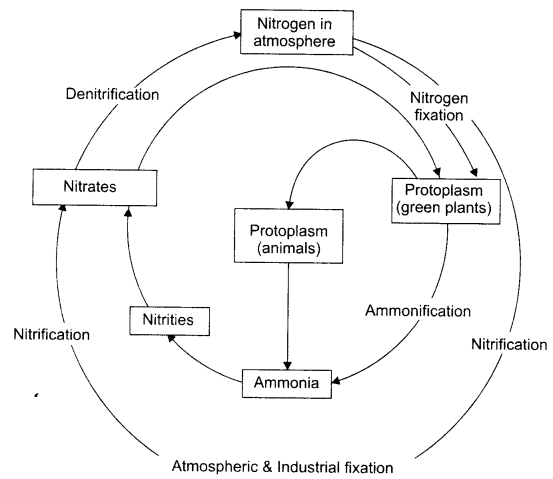
The nitrogen cycle in the biosphere involves the following important steps:
1. Ammonification: It is the process of decomposing complex, dead organic matter into ammonia. This is done by micro-organisms living in the soil, e.g., decay bacteria and fungi.
2. Nitrogen fixation: The process involves converting atmospheric nitrogen into nitrates, which are soluble in water. This is done by various N2 fixing bacteria, e.g., Rhizobium, blue-green algae and bacterium azatobactor.
3. Denitrification: It is the process of reducing nitrates present in the soil, to release nitrogen gas back into the atmosphere, i.e., pseudomonas.
4. Nitrification: It is the process of conversion of ammonia into nitrites and then into nitrates. This is done by nitrifying bacteria, e.g., nitrosomonas and nitrobacter. Thus, there is a nitrogen cycle in nature, in which nitrogen passes from its elemental form in the atmosphere into simple molecules in the soil and water, which gets converted to more complex molecules in living beings and back again to the simple nitrogen molecules, in the atmosphere.
Environment Additional Questions Solved
Multiple Choice Questions (MCQs)
Question 1.
Abiotic factors of the environment are:
(A) Sunlight
(B) Temperature
(C) Rainfall
(D) All the above
Answer: D
Question 2.
The physical and biological world we live in is called:
(A) Environment
(B) Community
(C) Population
(D) Ecosystem
Answer: A
Question 3.
Biotic component of Ecosystem consists of:
(A) Producer
(B) Consumers
(C) Decomposers
(D) All the above
Answer: D
Question 4.
What is common to the habitat and the environment?
(A) The biotic factors
(B) The abiotic components
(C) Both biotic and abiotic components
(D) None of the above
Answer: C
Question 5.
A pond is:
(A) A Biome
(B) A natural ecosystem
(C) An artificial ecosystem
(D) A community of plants and animals only
Answer: B
Question 6.
A plant grown in the environment is related to:
(A) Other plants of area
(B) Soil of area
(C) Presence of light
(D) All of the above
Answer: D
Question 7.
Example of sedimentary cycle in biosphere ‘is:
(A) Phosphorus cycle
(B) Oxygen cycle
(C) Nitrogen cycle
(D) Carbon cycle
Answer: A
Question 8.
Which of the following is an abiotic component of the ecosystem:
(A) Bacteria
(B) Plants
(C) Humus
(D) Fungi
Answer: C
Question 9.
The compound responsible for the depletion of ozone layer is:
(A) Sulphur dioxide
(B) Chlorofluorocarbon
(C) Alkyl halide
(D) Organo-Mercury compounds
Answer: B
Question 10.
Polluted water can cause:
(A) Typhoid
(B) Kidney trouble
(C) Malaria
(D) Pulmonary disease
Answer: A
Question 11.
The main cause of a cough, asthma and tuberculosis is:
(A) Air pollution
(B) Water pollution
(C) Noise pollution
(D) All the above
Answer: A
Question 12.
Which is helpful in checking air pollution:
(A) Animals
(B) Factories
(C) Means of Transport
(D) Trees
Answer: D
Environment Very Short Answer Type Questions
Question 1.
Define Environment?
Answer
The physical and biological world, we live in is called our environment.
Question 2.
Name the living components of the iosphere.
Answer
The living components of the iosphere are producers, consumers and decomposers.
Question 3.
Name the types of an aquatic ecosystem?
Answer
Aquatic ecosystems are:
- Freshwater ecosystem,
- Marine water ecosystem
Question 4.
Name two types of Ecosystem.
Answer
(a) Natural Ecosystem,
(b) Artificial Ecosystem
Question 5.
What is biosphere?
Answer
Life supporting zone of the earth is called living mantle or biosphere.
Question 6.
What is thermal pollution?
Answer
Passage of hot water from industries and thermal plants into water bodies changes the temperature latter and leads to pollution called thermal pollution.
Question 7.
What is air pollution?
Answer
Undesirable change in characteristics of air is called air pollution.
Question 8.
What is water pollution?
Ans.
Contamination of water with unwanted and harmful substances is called water pollution.
Question 9.
What is a biogeochemical cycle?
Answer
The flow of nutrients between living and non-living environment is a biogeochemical cycle.
Question 10.
What is the water cycle?
Answer
Process in which water evaporates, fall on earth and flows back to sea again, is called water cycle.
Environment Short Answer Type Questions
Question 1.
Differentiate between the lithosphere, hydrosphere and atmosphere.
Answer
(a) The lithosphere is the outer crust of the earth, constituted, up of soil, rocks and minerals.
(b) Hydrosphere is constituted by the water content of the earth that includes water vapour in the air, water on the earth’s surface and underground water.
(c) The atmosphere is constituted of the air that covers the whole of the Earth like a blanket.
Question 2.
List any three human activities which could lead to an increase in carbon dioxide content of air?
Answer
The three important human activities which increase the atmospheric CO2 are:
Combustion: Combustion of fuels, coal, petroleum products, cowdung, etc. considerably increases CO2 content of the air.
Respiration: Human beings release CO2 into the atmosphere as a by-product of oxidative metabolism.
Deforestation: Cutting of trees by human beings, for their material advantage, is responsible for the increase in CO2 content of the air.
Question 3.
List three human activities responsible for water pollution.
Answer
(a) Disposal of industrial waste, which contains poisonous substances into nearby water bodies.
(b) Excessive use of fertilisers and pesticides.
(c) Hot water released from industrial units.
(d) Synthetic soap and detergents, used for washing in household units.
(e) Sewage discharged into sewers from household/domestic units.
Question 4.
What is the difference between abiotic and biotic components?
Answer
The differences are:
- Abiotic components: The abiotic components of the environment are air, water, soil, light and temperature.
- Biotic components: The biotic components of the environment are plants, animals, including human beings and micro-organisms.
Question 5.
Define biosphere?
Answer
The biosphere is the sum of all physical and biological conditions, which influence the processes of organisms things in an environment. It is the single largest self-sustaining biological system. It is subdivided into:
Lithosphere: It includes all solid components of the earth.
Hydrosphere: It includes all liquid components of the earth.
Atmosphere: It includes the gaseous part of e earth.
Question 6.
What is soil pollution? How does it cause?
Answer
Removal of useful components from the soil and the addition of other substance, i.e. fertilisers, pesticides, which adversely affect the fertility of the soil and kill the various organisms in it, is called soil pollution. Causes of Soil Pollution: Soil pollution is caused by solid wastes and chemicals. The slag heaps from mines spoil the beauty of mining sites The major sources of soil pollution are the industries, such as pulp and paper mills, sugar mills, oil refineries, power plants, chemicals and fertiliser manufacturing units, iron and steel plants, plastic and rubber industries and many more. Most industrial furnaces and thermal power stations produce fly ash, which is a grey, powdery residue of unburnt material, and causes pollution. Our domestic waste includes a large amount of solid waste. They include food scraps, vegetable remains, packing materials, cans, rags, papers, cinders, ash, broken gadgets, wood, metals, plastics, polythene bags, ceramics, glass, aluminium, rubber, leather, construction rubbish, bricks, sand and other junk materials.
Environment Long Answer Type Questions
Question 1.
Define the classification of biotic factors in an ecosystem? Explain the importance of each factor?
Answer
Biotic component means the living components of an ecosystem. On the basis of food relations, they can be put in the following categories-
(a) Producers
(b) Consumers,
(a) Producers: They are the living members of an ecosystem which synthesise their own food. Green plants are called producers because they are able to synthesise their food in the presence of sunlight and chlorophyll by taking carbon dioxide from the atmosphere and water from the soil. They are also called as autotrophs as they synthesise their own food. As green plants can convert solar energy into chemical energy of food, so they can also be called converter.
(b) Consumers or Heterotrophs:
Consumers or heterotrophs are those animals which eat foodstuffs manufactured by green plants. They cannot manufacture their own food. Phagotrophs are such heterotrophic organisms which digest their food within their body.
Consumers are of three types:
- Primary Consumers: All the herbivores which feed on producers (green plants) are called primary consumers. Some common examples of primary consumers are insects, goat, cow, rabbit, grasshopper, deer, parrot etc.
- Secondary Consumers: Carnivores eat the herbivores or primary consumers and are called secondary consumers. Some common examples of secondary consumers are a snake, frog, fox, lizard, etc. They are also called primary carnivores.
- Tertiary Consumers: They are also called secondary carnivores. Big carnivores eat the secondary consumers and are called as tertiary consumers. Lion and tiger are common examples of tertiary consumers.
- Omnivore: An animal which eats plants, as well as flesh of other animals, is called omnivore. Man is an example of an omnivore.
(c) Decomposers or Micro consumers or osmotrophs or saprotrophs: These are the micro-organisms which feed on dead bodies of plants and animals and break down complex organic substances into simpler inorganic substances. Putrefying bacteria and fungi decompose the dead plants and animal bodies into ammonia and other simpler substances. Through the decomposers, the elements enter the earth again, which are again taken up by plants. Thus, the cycle of matter continues.
Question 2.
Explain the causes of water pollution. Discuss how you can contribute in reducing water pollution.
Answer
Some of the sources, effects, causes and controlling measures of water pollution are listed below:
(a) Microbial growth: Sewage from big cities is usually drained into rivers. This sewage promotes the growth of microscopic bacterial life. This excessive growth depletes the oxygen of water and causes the death of these bacteria and other aquatic organisms.
(b) Oil: Oil-spills and washing of automobiles can pollute rivers.
(c) Effluents: Industrial wastes include a variety of poisonous chemicals, which are drained into nearby waters. The chemicals include acids, alkalis and a variety of salts.
(d) Fertilisers and Pesticides: Due to the good solvent property of water, it dissolves the fertilisers and pesticides, that we use in our farms. So, some percentage of these substances are washed away in the water-bodies,
(e) High Temperature: Hot water released from factories and power generators cause thermal pollution of water. The temperature of water in rivers is also affected when water is released from dams. The water inside the deep reservoir would be colder than the water at the surface, which gets heated by the sun. Water pollution can be controlled by avoiding the addition of pollutants in various water-bodies.
Some of the control measures of water pollution are as follows:
- Effluent Treatment: All effluents from factories should be cleaned off, before releasing into rivers or other water bodies.
- Sewage Treatment: Sewage should be fully treated before releasing into the rivers or fields. Biogas produced in sewage treating tanks is a valuable kitchen gas and the left-over solid is rich manure.
- The use of fertilisers and pesticides should be avoided.
- No garbage should be thrown in the nearby water bodies.
Question 3.
(a) Draw a labelled diagram of the oxygen cycle in nature and explain?
(b) How does replenishment take place?
Answer
(a) Oxygen cycle: Oxygen form about 21% of all the atmospheric gases. It is also present in dissolved form in water bodies and helps in use survival of aquatic life. Oxygen is also present in combined forms, such as carbon dioxide (CO2) and water (H2O). It is also present in the combined form in the earth’s crust as the oxides of metals and silicon. Oxygen is an essential component of most biological molecules like proteins, carbohydrates, nucleic acids and fats. All living organisms, plants, animals and decomposers, take oxygen from their surroundings and utilise it for respiration. Oxygen also enters the plants as C02 during photosynthesis, and into all the organisms in the form of water. Oxygen is utilised in decay and decomposition of dead organisms, and also in the burning of fuels, such as wood, coal and petroleum. Here, again, the by-products, CO2 and H2O are released into the atmosphere.
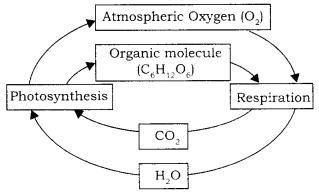
The green plants, in turn, utilise carbon dioxide and water to prepare carbohydrates through photosynthesis, releasing oxygen as a by-product. In fact, green plants are a major source of oxygen in the atmosphere.
(b) Replenishment: Photosynthesis is the source of replenishment of atmospheric oxygen. During photosynthesis, carbon dioxide is consumed along with water and oxygen gas is liberated. Oxygen gas is liberated during photosynthesis, comes from water. Thus, oxygen utilized in the form of H,0 and C02 is replenished back into the earth’s atmosphere.
Question 4.
(a) With the help of well-labelled diagram, explain the water cycle in nature?
(b) Explain how is greenhouse effect related to global warming?
Answer
(a) Hydrogen is the main element of water and is circulated along with water. Water is available from various sources in the form of water vapour. Water evaporates from water bodies, such as oceans, lakes, rivers, and also from living organisms. Animals excrete water as urine and sweat, which eventually evaporates and plants, transpire, thus contributing to the water-vapour content in the atmosphere. Water vapour from the above sources gets condensed at low temperature, in the upper reaches of the atmosphere and form droplets. These droplets get collected to form clouds, which when turning heavy, fall as rain and snow. This process is referred to as precipitation. Thus, water returns to the earth. The water cycle makes fresh water available to the organisms. The water cycle is also meant for the cycling of hydrogen, one of the macronutrients for plants. Plants use’water, mainly as a source of hydrogen for reducing carbon dioxide, during photosynthesis. During the light reaction of photosynthesis, water is split into H+ and OH ions. From these, hydrogen is used for fixing carbon dioxide and oxygen is removed as a by-product.
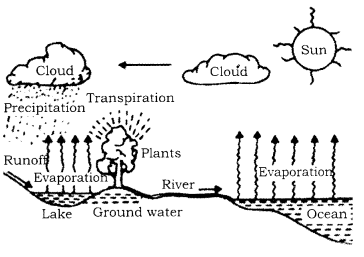
(b) CO2 and methane absorb the infrared radiations from the earth. They trap the heat within the atmosphere, preventing its escape into space. The carbon dioxide of the atmosphere keeps the earth warm, much like the glass which keeps the greenhouse warm. That is why this effect is called greenhouse effect. Without the greenhouse effect, the earth would be too cold for life. But the increase in the amount of CO2 and methane has led to global warming, i.e., an increase in the average temperature of the earth. Global warming may lead to melting of polar ice caps and ultimately rise in sea level.
Question 5.
Make a schematic diagram of the carbon cycle? What are the two ways in which carbon dioxide is fixed in the environment?
Answer
Carbon dioxide content is about 0.03 per cent in the atmosphere. Carbon dioxide cycle involves the cycling of carbon, which is a basic component of all the organic compounds that build all the living things. Atmospheric CO2 and dissolved CO2 in the water are the basic sources of carbon. Carbon moves from the atmosphere to producers, to consumers and from both to the decomposers and finally back to the atmosphere. Carbon is also found in water, fossil fuels and sedimentary rocks.
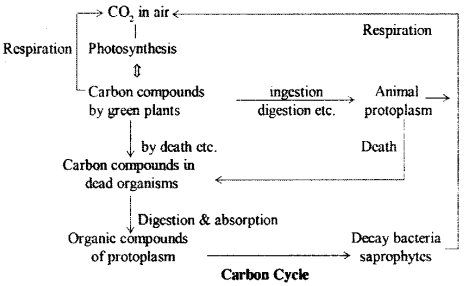
In the first step, CO2 is fixed in photosynthesis, mainly by the green plants. The plants synthesise simple sugar by photosynthesis, which later gets converted into polysaccharides and fats and stored in their tissues. When plants are feed by animals, these are digested and synthesised in other forms. Much of the carbon is returned back to the atmosphere in the form of gas, as a result of respiration in producers and consumers. Carbon from animal excreta, in the protoplasm of plant and animals, is released by bacterial and fungal activities, when they die. CO2 is also released by the burning of fossil fuels, which enters the atmosphere.
Question 6.
What is ozone? Discuss its role in protecting the life on earth. Which human activities are depleting ozone layer? Show a picture of the ozone hole over Antarctica.
Answer
Ozone is a form of triatomic oxygen (O3) molecules which is highly poisonous to a living system. There is a layer of ozone, Os, surrounding the earth. It is 5 km thick located at a distance of 25-30 km from the earth’s surface. Ozone performs an essential function for us. It cuts out some of the ultraviolet light coming from the Sun. Ultraviolet light is bad for us and for crops. Long exposure to ultraviolet light can cause skin cancer, damage to eyes and immune system. An excess of ultraviolet light kills phytoplankton, the minute aquatic plant life. It may also disrupt global rainfall, cause ecological disturbances and bring about a reduction in global food supplies.
The following are the main cause of depletion of the ozone layer:
There are several reasons for the depletion of the ozone layer. The foremost is the use of chlorofluorocarbons CFCs, (CFC’s is” a man-made compound). The other factor responsible for ozone destruction is the pollutant nitrogen monoxide (NO). CFCs are very stable and are found to persist in the atmosphere. Once, they reach the ozone layer, they react with the ozone molecules, resulting in the reduction of the ozone layer. A few years back, a hole in the ozone layer was discovered above Antarctica.
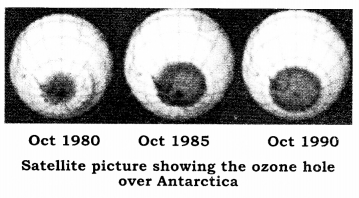
We hope the given RBSE Solutions for Class 9 Science Chapter 13 Environment will help you. If you have any query regarding Rajasthan Board RBSE Class 9 Science Chapter 13 Environment, drop a comment below and we will get back to you at the earliest.